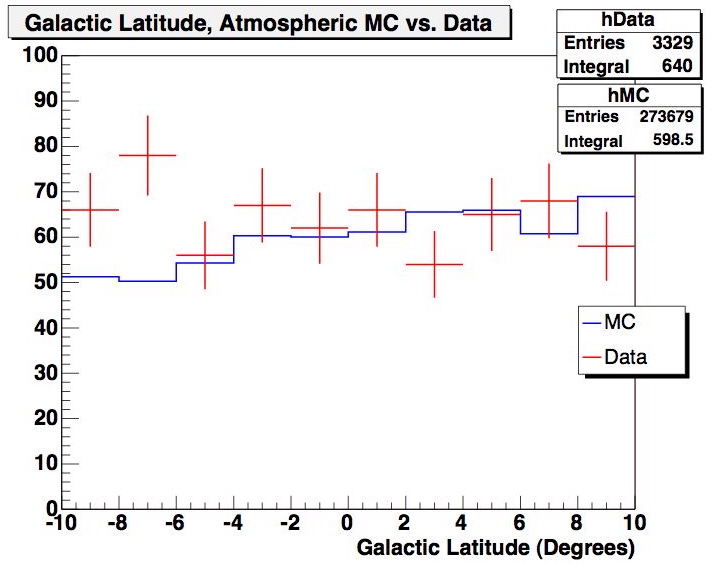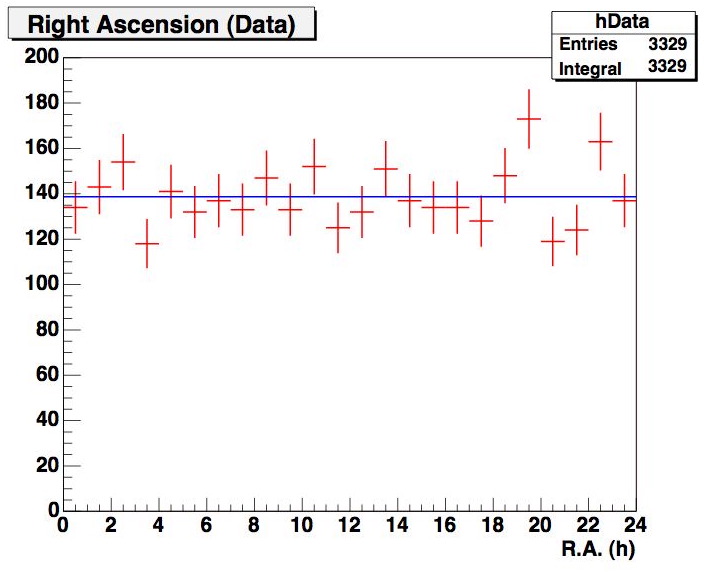John Kelley, UW-Madison, May 2005
![]()
As discussed in the previous section, the on-source region size is the primary optimization for this analysis. The optimization has been performed for two signal profiles — a line source and a Gaussian of sigma 2.1 degrees, both constant in galactic longitude. The optimimum on-source region size is +/-2 degrees for the line source and +/-4.4 degrees for the Gaussian.
I propose to unblind the data and calculate the limit for both on-source region sizes. Assuming no signal is present, the 2 degree limit will correspond to the line source, as well as the estimated diffuse step-function flux in that on-source region. The 4.4 degree limit will correspond to the Gaussian of 2.1 degrees.
There is still an ongoing investigation into the uniformity of the background in right ascension (see question #5 in section 5). If a problem shows up in the data that would suggest the background should be re-estimated, this will be done. However, the cuts as described will not be changed or re-optimized — only the limit will be corrected. If a problem shows up but the background cannot be easily re-estimated, the limit will be conservatively corrected to incorporate a systematic uncertainty in the background.
The data have been unblinded (rebooked using unscrambled files) and have been checked for consistency with the master event list from Zeuthen.
No significant excess (or deficit) of events is seen.
As described above, two on-source region sizes were examined, one optimized for a line source, and one optimized for a Gaussian of width 2.1 sigma. Events were counted in the on-source region, and backgrounds estimated as described in section 5. The confidence intervals were then calculated with Peter Nießen's coli software.
The results for a spectral index of -2.7 are presented in the following table:
On-source window (degrees) |
On-source events |
Expected background |
Line-source limit (per radian) |
Diffuse limit (per steradian) |
Gaussian limit (per steradian) |
+/- 2 |
128 |
129.4 |
5.8e-5 |
6.1e-4 |
— |
+/- 4.4 |
272 |
283.3 |
— |
— |
4.4e-4 |
Table 6.1 Summary of results (spectral index of -2.7).
Limits do not include systematic errors or adjustments for oscillations.
Units are inverse (GeV cm^2 s rad) for the line source limit, and per steradian for the diffuse limit (valid in the on-source region) and the Gaussian limit. The procedure for calculating the diffuse and Gaussian limits from the line-source limit is described in the previous section.
A plot of the distribution of the data (and atmospheric MC) in galactic latitude is shown below:

Figure 6.1: Unblinded galactic latitude distribution around the galactic equator.
It is also apparent from this plot that there is no excess around the galactic equator.
The limits for other spectral indices have also been calculated (using the +/-2 degree on-source window):
Spectral index |
Line source limit |
Diffuse limit (per steradian) |
-2.4 |
4.7e-6 |
4.9e-5 |
-2.5 |
1.1e-5 |
1.1e-4 |
-2.6 |
2.6e-5 |
2.7e-4 |
-2.7 |
5.8e-5 |
6.1e-4 |
-2.8 |
1.3e-4 |
1.4e-3 |
-2.9 |
2.7e-4 |
2.9e-3 |
Table 6.2: Limits for other spectral indices, for the +/- 2 degree on-source
window.
Systematic errors and adjustments for oscillations are not included.
Given the recent discussions around background estimation and possible problems in the distribution of right ascension, I have plotted the RA of the unblinded data, along with the average value. No significant structure is seen.

Figure 6.2: Right ascension distribution of unblinded data.
The blue line is the average value.